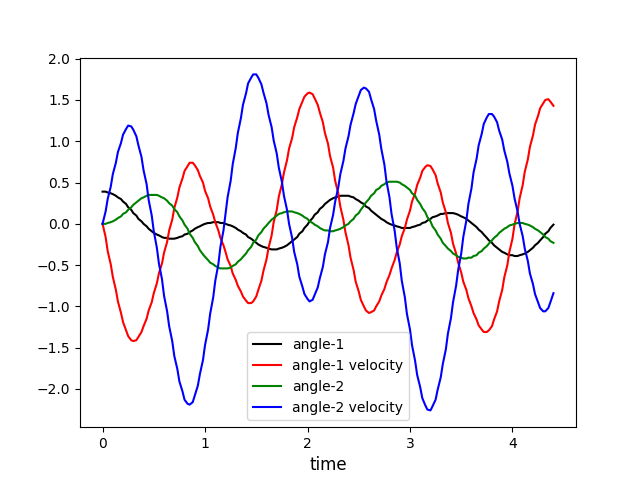
Here is an example Python program for graphing numeric data from the Double Pendulum simulation. See Getting Numbers with VarsHistory for how to obtain the numeric data.
# graph data in the file dbl-pendulum-data.txt
# that file was created in the DoublePendulum simulation on myphysicslab
# using the following script:
# var hist = new VarsHistory(sim.getVarsList());
# simRun.addMemo(hist);
# hist.setNumberFormat((n) => n.toFixed(2));
# hist.setVariables([9,0,1,2,3]);
# hist.memorize()
# the variables in the file are:
# time angle-1 angle-1 velocity angle-2 angle-2 velocity
import matplotlib.pyplot as plt
hnd = open("dbl-pendulum-data.txt", "r")
# arrays to collect (x,y) points for later plotting
ta = [] # time array
ya1 = []
ya2 = []
ya3 = []
ya4 = []
line = 0
while True:
buff = hnd.readline()
if not buff:
break
line += 1
buff=buff.strip()
if line==1:
names = buff.split('\t')
if line>1:
b = [float(x) for x in buff.split()]
if (len(b)<5):
continue
ta.append(b[0])
ya1.append(b[1])
ya2.append(b[2])
ya3.append(b[3])
ya4.append(b[4])
hnd.close()
plt.plot(ta, ya1, 'k', label=names[1])
plt.plot(ta, ya2, 'r', label=names[2])
plt.plot(ta, ya3, 'g', label=names[3])
plt.plot(ta, ya4, 'b', label=names[4])
plt.xlabel('time', fontsize=12)
plt.legend()
plt.show()
It produces this graph

The data file begins with the following lines
time angle-1 angle-1 velocity angle-2 angle-2 velocity
0.00 0.39 0.00 0.00 0.00
0.03 0.39 -0.16 0.00 0.15
0.05 0.38 -0.33 0.01 0.30
0.08 0.37 -0.49 0.02 0.45
0.10 0.36 -0.64 0.03 0.60
0.13 0.34 -0.80 0.05 0.74
0.15 0.32 -0.94 0.07 0.87
0.18 0.30 -1.08 0.09 0.98
0.20 0.27 -1.19 0.12 1.08
0.23 0.24 -1.29 0.14 1.15
0.25 0.20 -1.36 0.17 1.19
0.28 0.17 -1.41 0.20 1.18
0.30 0.13 -1.42 0.23 1.14
0.33 0.10 -1.41 0.26 1.06
0.35 0.06 -1.37 0.28 0.95
0.38 0.03 -1.31 0.31 0.81